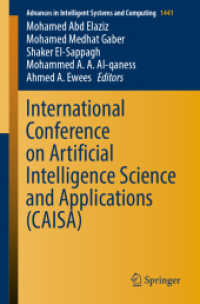Full Description
In Following the Proper Channels: Tributaries in the Mekong Legal Regime, Bennett Bearden offers in-depth policy and legal analyses of the marginalization of tributaries in the context of the 1995 Agreement on the Cooperation for the Sustainable Development of the Mekong River Basin, law of international watercourses, hydrosovereignty, and the national economic development interests of the Mekong riparians. As a problem-based study, enlightening conclusions are made based on the increasingly state-centric nature of water resources management in the Mekong region through pursuit of national agendas in the unilateral and bilateral development of tributaries. The overarching legal and hydropolicy issue is whether states can simultaneously pursue hydrosovereignty on tributaries and ensure the Mekong legal regime's efficacy to achieve holistic water resources management and basin-wide governance.
Contents
Acknowledgments
Abstract
List of Illustrations
List of Abbreviations
List of Legislative Materials
List of Cases
Introduction
1 The Mekong River Basin
1.1 Physical Setting
1.2 Geology and Geomorphology
1.3 Climate
1.4 Water Resources
1.5 Mekong Tributaries
1.5.1Tributaries in the Context of Holistic Water Resources Management
1.6 Chapter 1 Conclusion
2 Legal and Institutional Framework
2.1 The Mekong Legal Regime: 1957-1995
2.1.11957-1975: The Mekong Committee, the 1957 Mekong Statute, and the Water Charter
2.1.21975-1978: The Joint Declaration
2.1.31978-1995: The Interim Mekong Committee
2.2 1995-Present: The 1995 Mekong Agreement
2.2.1The Mekong River Commission (mrc)
2.2.2National Interests and Water Law
2.2.3The Role of International Water Law
2.2.4Waterscapes
2.2.5Salient Provisions of the 1995 Mekong Agreement
2.2.6The Sustainable Development Paradigm
2.2.7Balancing Water Quality and Water Quantity in the Mekong Regime
2.3 Chapter 2 Conclusion
3 A Retrospective Look at Tributary Watercourse Law in the Mekong and Other Selected Legal Regimes
3.1 Evolution of Article 5(A) in the Mekong Legal Regime
3.2 Tributary Watercourse Law in Other Selected Legal Regimes
3.2.1The 1909 Boundary Waters Treaty (us and Canada)
3.2.2The 1961 Columbia River Treaty (us and Canada) and the Okanagan River Basin
3.2.3A Community of Interest in Mekong Tributaries? The Influence of the River Oder and the Gabcikovo-Nagymaros (Hungary/Slovakia) Cases
3.2.4Arizona v. California
3.2.5The Nigeria-Niger Tributary Agreement
3.3 Chapter 3 Conclusion
4 Mekong Tributaries: Selected Case Studies
4.1 Hydropower Development on the Sesan River
4.1.1The Sesan River
4.1.2Development of the Yali Falls Dam
4.2 The Thai Water Grid
4.3 The Legal and Scientific Imperatives for De-marginalizing Tributaries in the Mekong Legal Regime: Dams, Water Diversions, Biogeography, and the Evolving Contours of Climate Change
4.4 Chapter 4 Conclusion
5 The Mekong: The Archetypal Dissevered River Basin
5.1 Introduction: The Dissevered River Basin Concept
5.2 Chapter 5 Conclusion
6 A Flawed Vision? Deficiencies in the Mekong Legal Regime
6.1 Learning to Get Along: China and the LMRB
6.2 The View Downstream: eias
6.3 The Transparency Issue: Stakeholder Participation and Access to Information
6.4 Crossing the Rubicon: Dispute Resolution
6.5 The Mekong Legal Regime Viewed through the Lens of the un Watercourses Convention
6.6 Chapter 6 Conclusion
7 Conclusion: Demarginalizing Mekong Tributaries and Shifting the Transformation of the Mekong Water Resources Spectrum Paradigm—A Proposal for the Way Ahead
Bibliography
Index







